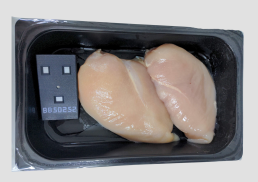SHELF LIFE STUDY
Does chicken last longer than the Use by date?
We explore the true shelf life of supermarket groceries in comparison with the printed use by dates. In our multi-part study, we start with chicken breast.

Unlocking extra life: Chicken breast
We conducted an experiment involving seven packs of chicken, stored at typical consumer refrigerator temperatures (8°C/46°F), to measure and analyze spoilage over time. Our findings suggest that extending the use-by date by one day beyond the current standard can potentially decrease waste in retail stores by 25%. This adjustment could lead to an annual saving of $17 million for the largest retailer in the U.S.
Method
We procured seven packs of chicken from a local supermarket and repackaged them using a sensor-equipped modified atmosphere packaging (30% CO2, 70% O2). These packages were stored at 8°C / 46°F, mimicking worst-case scenario conditions in consumer fridges. Our sensors continuously monitored spoilage gases and temperatures throughout the product’s shelf life. The data was displayed on our cloud-based web application. BlakBear’s machine learning algorithms translated these sensor readings into microbiological counts (total plate count, cfu/g), termed “digital micro”. The end of the shelf life was determined when the digital micro reached 1×107 cfu/g, a commonly recognized international spoilage threshold for fresh proteins. Accordingly, our measured use-by date is one day before reaching this spoilage limit.
Conclusion
Our study confirmed that the chicken’s shelf life could be extended by one day, in worst-case conditions, without compromising food quality. While seemingly minor, a one-day extension in shelf life could reduce food waste in retail stores by 25%, for example by increasing potential sales time from five to six days. For the top retailer in the United States and the United Kingdom, this change represents potential savings of $16.8 million and £6.8 million, respectively, in reduced chicken waste.
Furthermore, nationally, extending the use-by date for chicken by just one day could lead to waste reductions valued at approximately £109 million in the UK and $830 million in the US.
References
- M.E. Buisman, R. Haijema, J.M. Bloemhof-Ruwaard, “Discounting and Dynamic Shelf Life to Reduce Fresh Food Waste at Retailers,” International Journal of Production Economics, Volume 209, 2019, Pages 274-284.
- BlakBear customer data and market research, assuming chicken accounts for 1.28% of food sales with a waste rate of 8% across stores and supply chains
What you'll receive:
A comprehensive report featuring spoilage and temperature data captured throughout the trial and a photo gallery documenting the condition of the meat with our sensors over the shelf life period.
See the data
Access detailed data and visual documentation from this trial. This offer is specially tailored for potential industry partners and food retailers.
90%
Our sensors have 90% correlation with microbiological spoilage organisms
Campden BRI concluded our sensor data shows strong correlation (R>0.9) with microbiological and sensory testing.

